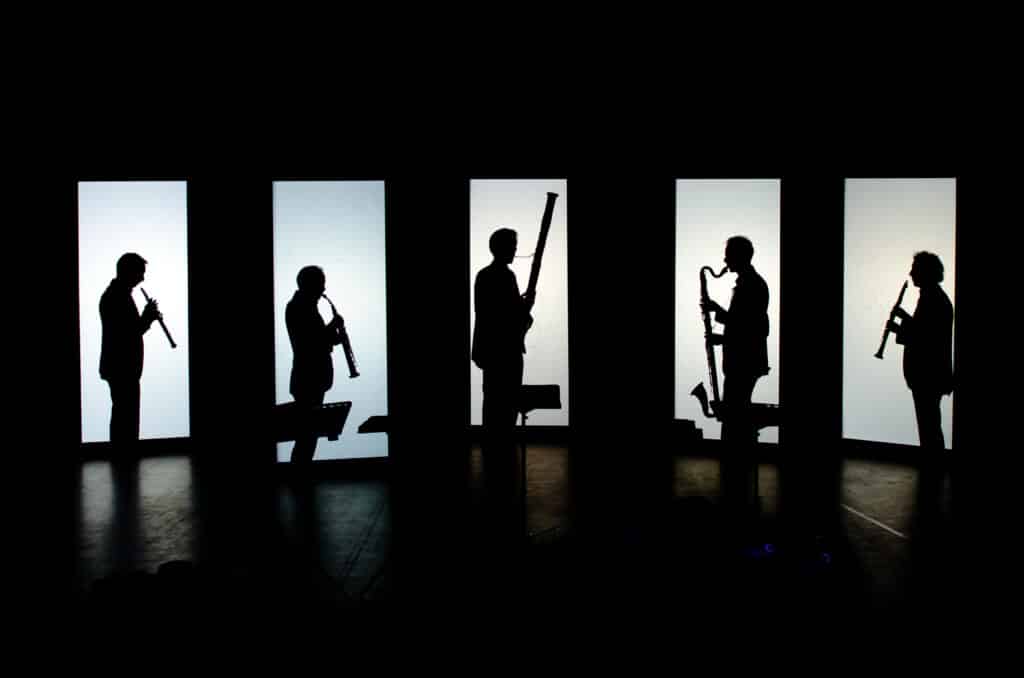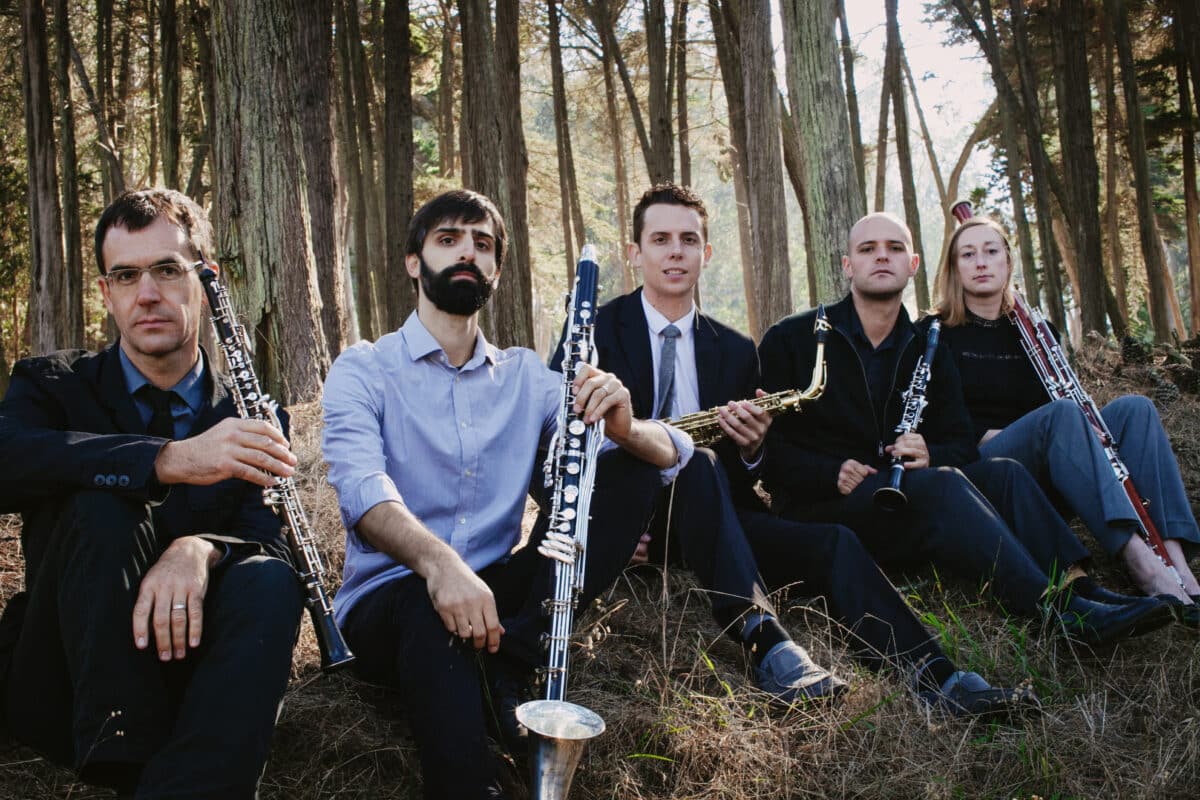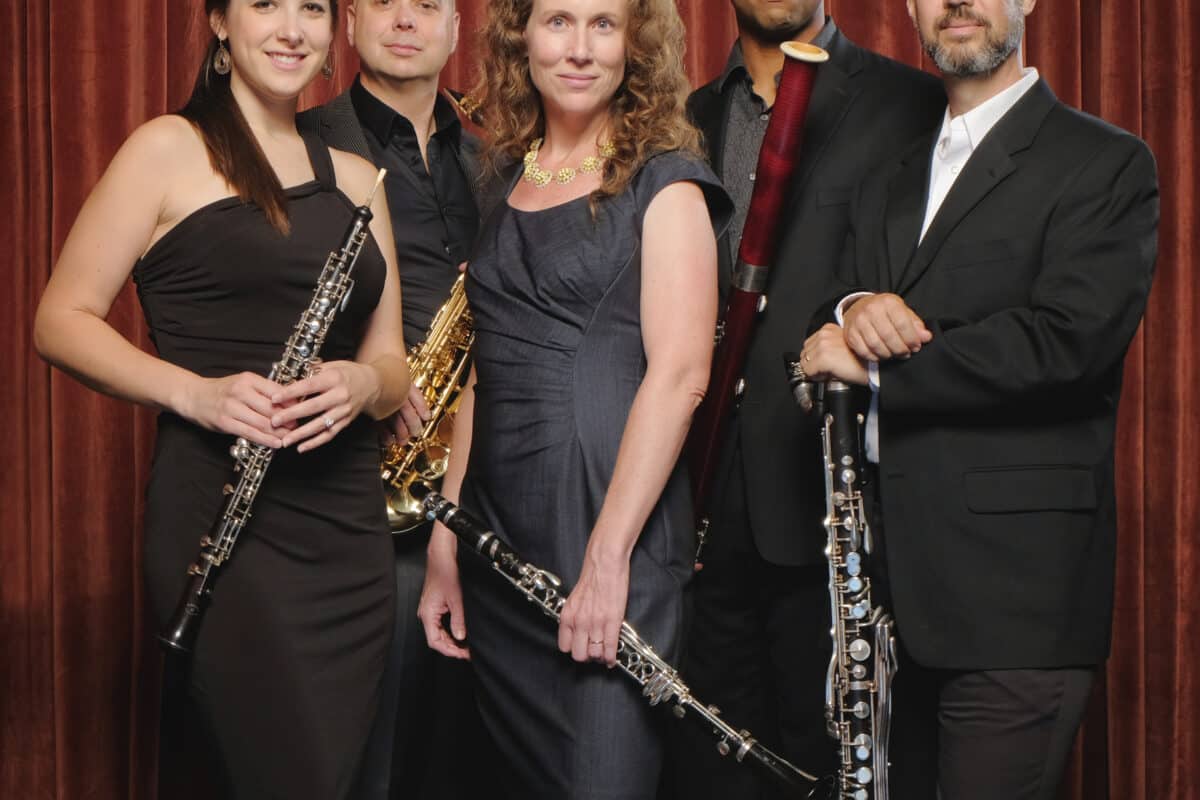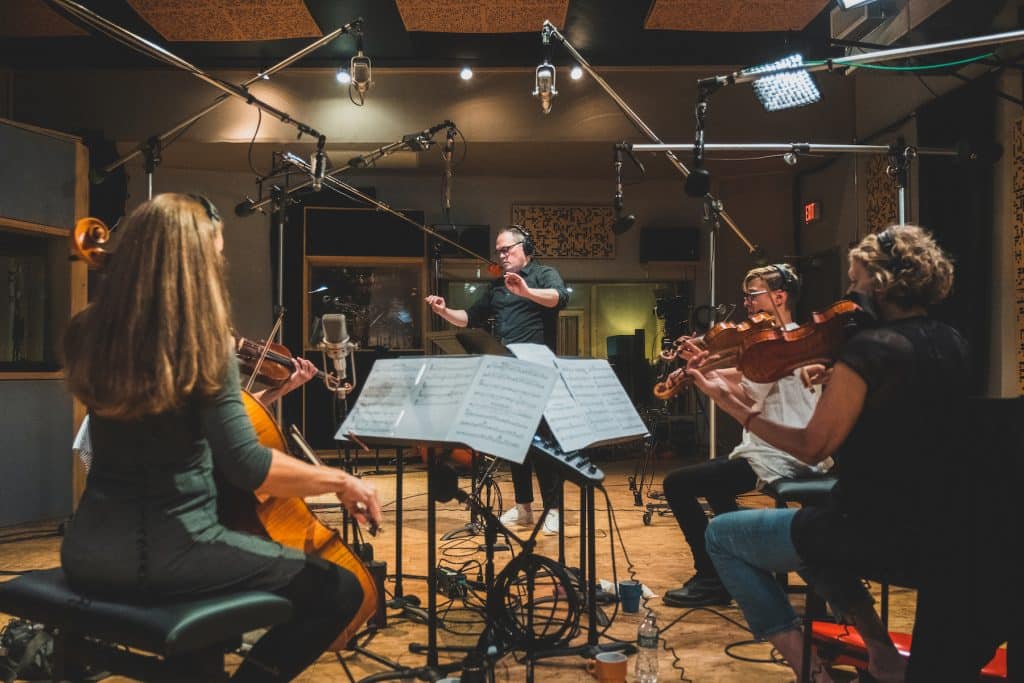The Rise of the Reed Quintet
How word of a new kind of chamber ensemble spread and took hold in Europe and then across the US.

In May of 2010, young Dutch families thronged Amsterdam’s august Concertgebouw to see and hear the first performances of The Music Factory, a theatrical production starring the beloved local chamber ensemble Calefax. Set in a telescope factory, the show casts Calefax’s five members as factory workers who stumble upon a series of musical discoveries. Turning on the factory machinery, they watch as it spits out a collection of distinctly non-telescopic objects: an oboe, clarinet, bassoon, bass clarinet, and saxophone. The five worker-musicians then begin to play, using only reeds and mouthpieces at first. An array of sounds emerges, along with a model of good-humored inventiveness. Undoubtedly, some of the young listeners leave with an ambition to try their own hands at wind instruments.
The Music Factory is a delightful kids’ show. But it’s also something more: a metaphor for one of the most unusual developments to emerge in the world of chamber music in the last thirty years. Calefax’s real-life members may not have invented instruments, but they did invent a new instrumental ensemble, the reed quintet. In need of a repertoire for that ensemble, they set in motion a kind of music-producing machinery, which—through commissions, new arrangements, and composition competition—continues to churn out a growing inventory of new works.
And having created a whole new sound-world, the group in turn inspired a generation of younger players to follow in its footsteps. Today, some twenty professional ensembles worldwide belong to the Calefax-curated Reed Quintet Network, including such American groups as Michigan’s Akropolis, San Francisco’s Splinter Reeds, Washington D.C.’s Atlantic Reed Consort, and Arizona’s Paradise Winds. As more and more reed quintets have gone to work in the last ten years, Calefax’s story has become their story, too.

The story of the reed quintet begins in 1985, when Calefax’s original members were high school students at Amsterdam’s Barlaeus Gymnasium. (For elder statesmen of the instrumentation, they are still quite young.) More or less by accident, the students formed an ensemble which subtracts from the traditional wind quintet its flute and horn, and replaces them with bass clarinet and saxophone. The years after graduation saw rapid personnel changes and ever-increasing numbers of concerts, with the group finally achieving its current form in 1997.
Their energies were protean. Working in a medium without any precedents, the five members contributed compositions, arrangements, and lessons learned from masters in other disciplines. Momentum built. After 2005, trans-Oceanic touring became a regular occurrence. (Their latest brings them to the U.S. this February.) Meanwhile, in 2004, the Calefax Edition of sheet music launched, followed quickly by institution of the Network and Competition.
By now, the group’s ceaseless push forward has produced over a thousand concerts, seventeen albums, two theatrical works, and staggering repertoire numbers: over 100 competition entries, 180 commissions and dedications, and—the heart of the group’s repertoire—around 250 self-made arrangements. These range from Bach’s Goldberg Variations to works of Debussy and Ravel, from Rameau to Shostakovich, Gesualdo to Nina Simone. Calefax plays them all with a unique blend of commitment, virtuosity, and flair.
An anecdote from Chamber Music San Francisco’s Dan Levenstein, recorded in the 2015 book Calefax and the Kaleidoscope, an exhaustive history of the group, shows how easily the group wins over audiences. “Although I was eagerly looking forward to their first concert,” says Levenstein, “I noticed many of our subscribers seemed puzzled by how a mere wind ensemble could be in the same season as groups like the Beaux Arts Trio.
“At the concert before Calefax’s, I stood on stage and said … ‘I know many of you are considering skipping our next concert … Let me convince you with this.’” After hearing just 30 seconds of Debussy’s Children’s Corner, Levenstein reports, listeners filled the theater for Calefax.
“I first encountered the reed quintet,” recalled John Romano, bass clarinetist for the Atlantic Reed Consort, “when I quite randomly purchased Calefax’s first album from a record store. It was the early ’90s; Tower Records was still a thing. I was looking for new wind music and liked the album cover. I was immediately a fan.” Hearing Calefax inspired Romano to start a reed quintet of his own—but there was one problem, he said. “Sheet music for that instrumentation wasn’t easily available.”
In the years before social media and streaming and downloads, news of the reed quintet’s birth spread slowly among wind players. But when word did arrive, it came for many as an answer to their prayers.
Like many aspiring reedists, Joey Kluesner, now bassoonist of the Arizona-based Paradise Winds, spent his formative years dissatisfied with the sonic palette of the more traditional wind quintet. “When I was coming up in school,” he said, “I would see string quartets play, and I was so jealous that the instruments were built for each other. I hated that I had to sit down next to a flute and a horn.”
Kyle Bruckmann, an oboist, composer, and founding member of Splinter Reeds, likewise yearned for a more unified sound. “The wind quintet doesn’t have access to the blend and the kind of meta-instrument, the mega-instrument, that a string quartet does,” said Bruckmann, who is also member of the wind quintet Quinteto Latino, and who professes an affinity for both ensemble configurations.
“The wind quintet repertoire is kind of a bastard, honestly,” he added. “We don’t have the multiple centuries of masterpieces to choose from that string quartets and piano trios do.
“Musically too, the best pieces of that repertoire are the ones that maximize the incompatibility of the five instruments,” Bruckmann said, “compositions like Barber’s Summer Music, that really just go for it in terms of maximizing the coloristic span and making the most of the strong individual personalities of the instruments.”
For Bruckmann, as for many other early adopters of the reed quintet format, Calefax’s innovation provided an elegantly simple solution. “Calefax had the brilliant idea to kick out the furthest outliers, the flute and the French horn, and say, if we replace that with the bass clarinet and sax, suddenly we have the potential for blend and a more unified palette,” he said. “We have a lot of individual personality and we have the option to crawl into each others’ sounds and make something that is twice as loud and boisterous and rich in overtones as a string quartet could ever dream of being.”
“When I discovered all reeds was an option,” Kluesener remembers, “that was the click: ‘Oh, we were born for this! Why haven’t we been doing this forever?’ It was mind-blowing.”

That first Calefax album Romano chanced upon included one piece, Ton ter Doest’s Circusmuziek (1990), that has emerged as a classic in a young repertoire. Every reed quintet seems to play it—and it’s not difficult to see why. Circusmuziek manages to be both wholly original and deeply connected to great moments in woodwind history: there’s the innocuously busy charm of a Jean Françaix, the big-city jazziness and tense atmospherics of film noir, and a melodious reediness of which Ravel and Prokofiev might have approved.
It’s probably no coincidence that the first flowering of American reed quintets—Eastwind Quintet got started in 2007, Akropolis and Paradise in 2009, Atlantic Reed Consort in 2010—closely followed the launch of the Calefax Edition, which includes Circusmuziek. Indeed, it was when Romano finally procured Ter Doest’s score and read it with Air Force Band colleagues that ARC got off the ground. Akropolis made a splash with Circusmuziek at the 2014 Fischoff Competition, having already made a stunning recording that rivals Calefax’s in its coloristic imagination and flamboyant energy.
Undoubtedly, Calefax’s originals and arrangements set the new ensembles on their way. But then, a funny thing happened. None of the new groups were content to just play someone else’s music. Calefax’s style and repertoire provided an impetus, but even more inspiring was the example they set. “I think all reed quintets share a certain upstart attitude towards music convention,” observes Romano. “That includes a willingness to embrace the old and the new and to try and forge a new relationship between audience and performer. It is a very DIY approach.” In a brand-new sound-world, everyone could be a trailblazer.

“We sound so different from Calefax,” says Akropolis saxophonist Matt Landry. “We never tried to emulate how they sounded, but just how polished they were … We immediately started doing our own thing. We had the idea that this is going to take a long time to become what we want it to be, so let’s start now, building our own style and vibe and sphere of influence.” Ten years in, Akropolis has made its mark as the most active American reed quintet, premiering more than fifty works and establishing the Akropolis Collection of arrangements and originals, sought after by both professionals and the burgeoning ranks of collegiate groups.
Underlining the wide-ranging and democratic nature of today’s reed quintet scene, Akropolis also excels in repertoire composed for other quintets, including Robbie McCarthy’s Paradise-commissioned Four-Letter Word, a portrayal of the composer’s boyhood punishment for using profanity; Chiel Meijering’s Calefax-commissioned The Woman Who Hatches Eggs, a quizzical work with echoes of Musorgsky; and Splinter, Marc Mellits’ imaginative portrayal of eight tree species—by turns knotty, supple, rough, majestic, willowy—which Splinter Reeds’ Bruckmann says Akropolis “plays the pants off of.”
Akropolis has performed at chamber venues across the country, and pioneered new ways to reach audiences: their YouTube Web Premiere Series has amassed more than 50,000 views. Meanwhile, nationwide educational visits have inspired students from middle-school to college level—as amply evidenced by YouTube comments.
Easy connection with young audiences turns out to be a natural advantage for a young genre. It helps that much of the reed quintet repertoire has built-in youth appeal. According to Paradise’s Kluesener, the fast movements of Splinter are “club music for woodwinds … the kids like that a lot”; while one of the central episodes of Four-Letter Word is “just like the end of a classic Nintendo game. You can tell it was written by a child of the gaming era.”
The young Driftwood Quintet of Arizona takes things even further, playing arrangements from game and anime soundtracks. “Half of our group are video game and movie nerds,” explains bass clarinetist Dominique Holley. But Driftwood also has a more serious side. “For me, as a minority musician,” said Holley, “it kind of pushed me in this direction like, ‘Hey, let’s play more pieces by composers who tell the stories of people that aren’t often told in music.’” Driftwood arrangements include compositions by members of Imani Winds, orchestral works by Arturo Márquez and William Grant Still, and Coleridge-Taylor’s setting of “Sometimes I Feel Like A Motherless Child.”



Calefax’s most rebellious disciple may be Splinter bassoonist Dana Jessen, who studied on a Fulbright in Amsterdam with Calefax’s Alban Wesly and recorded with the expanded ensemble CalefaXL. Jessen returned to the States with her sights set on a different sort of group. “When I left the Netherlands, I knew I wanted to play in a reed quintet that just did contemporary music,” she said. Landing in the Bay Area, Jessen gathered a quintet of what colleague Bruckmann called “new music dorks,” and unpacked a stack of music she’d gotten from Calefax. The group bonded over Ned McGowan’s Wood Burn, a piece improbably inspired by both Indian Carnatic music and the Swedish tech metal band Meshuggah.
Committed to cultivating relationships with the most cutting-edge composers, Splinter brings to the table a unique skill-set which includes improvisation and what Bruckmann describes as Jessen’s “signature vocabulary of multiphonics and extended reedless playing.”
Some ensembles might be cautious programming these sounds for traditional audiences. But, said Bruckmann, “it’s always been our M.O. that if we are geeked out about a piece, the odds are much higher that we’re going to get an audience excited about it. I hate the apologetic approach to presenting new music. ‘This is hard, but if you eat your Brussels sprouts it’ll be good for you.’ We’ve always actively countered that with a little more of a ‘Gee-gosh, this is crazy, wait until you hear this, this is gonna tickle your ears in a way that you may not have voluntarily subjected yourself to before.’”
Bruckmann reports that, at a recent performance for a rural audience in Paonia, Colorado, “we went in with that approach and it completely worked. We were delighted by the reactions we got.
“That was a very instructive experience. There’s something sufficiently novel in both what we do and in what the reed quintet does, period, that there are fewer preconceptions to overcome. It’s a more blank slate with audiences. I think that’s very exciting territory.”



